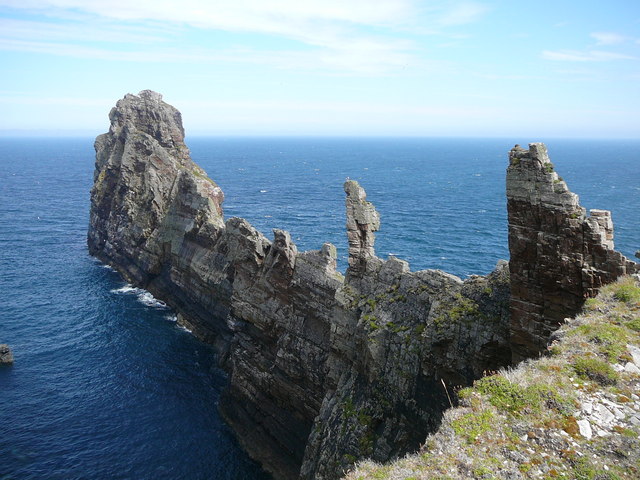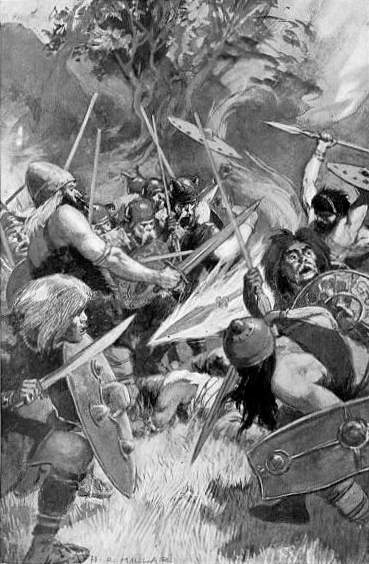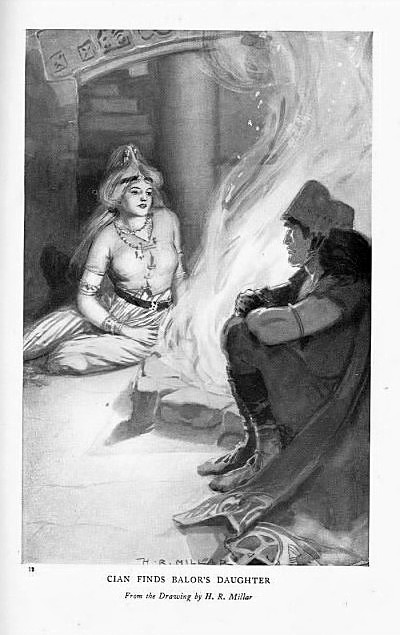|
Balor
In Irish mythology, Balor or Balar was a leader of the Fomorians, a group of malevolent supernatural beings. He is often described as a giant with a large eye that wreaks destruction when opened. Balor takes part in the Battle of Mag Tuired, and is primarily known from the tale in which he is killed by his grandson Lugh of the Tuatha Dé Danann. He has been interpreted as a personification of the scorching sun, and has also been likened to figures from other mythologies, such as the Welsh Ysbaddaden and the Greek Cyclops. Name The name ''Balor'' or The Lonni may come from Common Celtic ''*Boleros'', meaning "the flashing one". In the early literature he is also referred to as ''Balor Béimnech'' (Balor the smiter), ''Balor Balcbéimnech'' (Balor the strong smiter), ''Balor Birugderc'' (Balor of the piercing-eye), ''Balor mac Doit meic Néid'' (Balor, son of Dot son of Nét) or ''Balor ua Néit'' (Balor, grandson of Nét). Later forms are ''Balor Béimeann'' or ''Balar Be ... [...More Info...] [...Related Items...] OR: [Wikipedia] [Google] [Baidu] |
Glas Gaibhnenn
Glas Gaibhnenn ( ga, Glas Gaibhnenn, Glas Ghaibhleann; Hiberno-English: Glas Gaivlen; Gloss Gavlen: pronunciation guide:/glas-gav-e-lan/;), in Irish folklore, is a prized fabulous cow of bounty (fertility) that yields profuse quantities of milk. The cow is owned variously by a smith who may be named Gaivnin (hence reinforcing the notion that the cow's name is eponymous after him) or by the hero Cian mac Cáinte (sometimes called Mac Kineely), equivalent to Cian father of Lugh of mythology. The cow is stolen (or craftily regained) by Balar or Balor the strong-smiter. The hero, in order to fulfill the quest to recover the cow, is transported by a banshee to a tower where Balor's daughter is sequestered, to produce a child destined to kill Balor. Name The normalized ga, Glas Gaibhnenn is O'Donovan's correction to the raw transcription Glas Gaivlen given by the storyteller; A different phonetic transcription Gloss Gavlen is given by Larminie. O'Donovan spelled the cow's name as G ... [...More Info...] [...Related Items...] OR: [Wikipedia] [Google] [Baidu] |
Cian
In Irish mythology, Cian or Cían (), nicknamed Scal Balb, was the son of Dian Cecht, the physician of the Tuatha Dé Danann, and best known as the father of Lugh Lamhfada. Cían's brothers were Cu, Cethen, and Miach. Cían was slain by the Sons of Tuireann, for which Lugh demanded various treasures around the world as éraic (compensation), according to the account in the "Book of Invasions" ('' Lebor Gabála Érenn'', LGE) as well as the late romance version "The Fate of the Children of Tuireann". Name Cían means "enduring one"; ''cían'' signifying "long, enduring, far, distant". Scal Balb Lebor Gabála Érenn, , p. 101 (Introduction); ¶311 p. 116 ¶330 p. 148–, ¶368 p. 186– is a nickname borne by other personages and means "dumb champion", with "dumb" in the sense of unable to make speech. By most accounts, Lug's mother is the Fomorian princess Ethniu, Lebor Gabála Érenn, ed. tr. ¶311 p. 117 but according to an interpolated text the LGE, Cían is also ... [...More Info...] [...Related Items...] OR: [Wikipedia] [Google] [Baidu] |
Lugh
Lugh or Lug (; ga, label= Modern Irish, Lú ) is a figure in Irish mythology. A member of the Tuatha Dé Danann, a group of supernatural beings, Lugh is portrayed as a warrior, a king, a master craftsman and a savior.Olmsted, Garrett. ''The Gods of the Celts and the Indo-Europeans''. University of Innsbruck, 1994. p.117 He is associated with skill and mastery in multiple disciplines, including the arts.Monaghan, Patricia. ''The Encyclopedia of Celtic Mythology and Folklore''. Infobase Publishing, 2004. pp.296-297 Lugh also has associations with oaths, truth and the law, and therefore with rightful kingship.Koch, John T. ''Celtic Culture: A Historical Encyclopedia''. ABC-CLIO, 2006. p.1200 Lugh is linked with the harvest festival of Lughnasadh, which bears his name. His most common epithets are ''Lámfada'' ("long hand" or "long arm", possibly for his skill with a spear or his ability as a ruler) and ''Samildánach'' ("equally skilled in many arts"). In mythology, Lugh is ... [...More Info...] [...Related Items...] OR: [Wikipedia] [Google] [Baidu] |
Cethlenn
In Irish mythology, Caitlín ( sga, Cethlenn, Cethleann, Ceithlenn, Ceithlionn, italic=no) was the wife of Balor of the Fomorians and, by him, the mother of Ethniu. She was also a prophetess and warned Balor of his impending defeat by the Tuatha Dé Danann in the second battle of Magh Tuiredh. During that battle she wounded the Dagda with a projectile weapon. She was also known by the nickname Cethlenn of the Crooked Teeth. Name Ceithlinn in modern Irish is pronounced like "Kehlen", and her name is sometimes indicated by that spelling. Kethlenda is the form of the name that appeared in Roderick O'Flaherty's ''Ogygia'' or ''Rerum Hibernicarum Chronologia'', written in Latin, reused as "Kethlenda of the Crooked Teeth" by story-reteller P. W. Joyce. ;Nickname Ceithlinn is called by the nickname Ceithlion Chaisfhiaclach "the crooked toothed" in the ''Oidheadh Chloinne Tuireann'', also translatable as "twisted teeth", from Irish ''cas'' 'twisted'. She is also glossed as being "buck ... [...More Info...] [...Related Items...] OR: [Wikipedia] [Google] [Baidu] |
Ethniu
In Irish mythology, Ethniu (), or Eithne ( Modern Irish pronunciation: ) in modern spelling, is the daughter of the Fomorian leader Balor, and the mother of Lugh. She is also referred to as Ethliu (modern Eithle), Eithlionn (genitive; modern Eithleann), and Ethlinn (dative; modern Eithlinn). Name Ethniu is a fine example of the difficulty of conducting research into Irish mythology. Her oldest version of her name is probably Ethliu or Ethniu, giving rise to the modern Irish name Eithne. However thanks to changes in the Irish language, the lack of standardised spelling for many centuries, and attempts to anglicise the name, variations have arisen. Linguistic ignorance has further confused the issue: the genitive form of ''Ethniu'' is ''Ethnenn'' (modern ''Eithneann'') and the genitive of ''Ethliu'' is ''Ethlenn/Ethlinn'' (modern ''Eithleann/Eithlinn''), as in ''mac Ethlenn'' ("Ethliu's son"). This genitive has often been taken for a nominative, or a mistaken nominative has be ... [...More Info...] [...Related Items...] OR: [Wikipedia] [Google] [Baidu] |
Fomorians
The Fomorians or Fomori ( sga, Fomóire, Modern ga, Fomhóraigh / Fomóraigh) are a supernatural race in Irish mythology, who are often portrayed as hostile and monstrous beings. Originally they were said to come from under the sea or the earth. Later, they were portrayed as sea raiders and giants. They are enemies of Ireland's first settlers and opponents of the Tuatha Dé Danann, the other supernatural race in Irish mythology; although some members of the two races have offspring. The Tuath Dé defeat the Fomorians in the '' Battle of Mag Tuired''. This has been likened to other Indo-European myths of a war between gods, such as the Æsir and Vanir in Norse mythology and the Olympians and Titans in Greek mythology. One theory is that the Fomorians were supernatural beings representing the wild or destructive powers of nature; personifications of chaos, darkness, death, blight and drought.MacCulloch, John Arnott. ''The Religion of the Ancient Celts''. The Floating Press, ... [...More Info...] [...Related Items...] OR: [Wikipedia] [Google] [Baidu] |
Tory Island
Tory Island, or simply Tory (officially known by its Irish name ''Toraigh''),Toraigh/Tory Island Placenames Database of Ireland. is an island off the north-west coast of , Ireland, and is the most remote inhabited island of Ireland. The name means "place of steep rocky heights". Language The main spoken language on the island is ...[...More Info...] [...Related Items...] OR: [Wikipedia] [Google] [Baidu] |
Mizen Head
Mizen Head ( ga, Carn Uí Néid) is traditionally regarded as the most southerly point of mainland Ireland. It is at the end of the Mizen Peninsula in the district of Carbery in County Cork. Geography Mizen Head is one of the extreme points of the island of Ireland and is a major tourist attraction, noted for its dramatic cliff scenery. One of the main transatlantic shipping routes passes close by to the south, and Mizen Head was, for many seafarers, the first (or last) sight of Europe. The tip of the peninsula is almost an island, cut off by a deep chasm, now spanned by a bridge; this gives access to an old signal station, a weather station, and a lighthouse. The signal station, once permanently staffed, is now a museum housing displays relating to the site's strategic significance for transatlantic shipping and communications, including the pioneering efforts of Guglielmo Marconi. The "99 steps" which formed part of the original access route have been supplemented by a se ... [...More Info...] [...Related Items...] OR: [Wikipedia] [Google] [Baidu] |
Cath Maige Tuired
''Cath Maige Tuired'' (modern spelling: ''Cath Maighe Tuireadh''; ) is the name of two saga texts of the Mythological Cycle of Irish mythology. It refers to two separate battles in Connacht: the first in the territory of Conmhaícne Cúile Tuireadh near Cong, County Mayo, the second near Lough Arrow in County Sligo. The two texts tell of battles fought by the Tuatha Dé Danann, the first against the Fir Bolg, and the second against the Fomorians. Etymology The word ''cath'' is an Old Irish word meaning "battle, combat". ''Mag'' is an earlier spelling of ''maigh'', meaning "plain". Ellis suggests that ''tuired'' (''tuireadh'' in modern spelling) means "pillars" or "towers",Ellis, Peter Berresford, ''The Mammoth Book of Celtic Myths and Legends'', 2002, pp 28 but the Royal Irish Academy's ''Dictionary of the Irish Language'' translates ''tuiredh'' as "a lament". Maigh Tuireadh is typically anglicised as Moytura or Moytirra. The First Battle of Mag Tuired The first text, some ... [...More Info...] [...Related Items...] OR: [Wikipedia] [Google] [Baidu] |
Tuatha Dé Danann
The Tuath(a) Dé Danann (, meaning "the folk of the goddess Danu (Irish goddess), Danu"), also known by the earlier name Tuath Dé ("tribe of the gods"), are a supernatural race in Irish mythology. Many of them are thought to represent deity, deities of pre-Christian Gaelic Ireland. The Tuath Dé are often depicted as kings, queens, druids, bards, warriors, heroes, healers and craftsmen who have supernatural powers. They dwell in the Celtic Otherworld, Otherworld but interact with humans and the human world. They are associated with the ''sídhe'': prominent ancient burial mounds such as Brú na Bóinne, which are entrances to Otherworld realms. Their traditional rivals are the Fomorians (Fomoire), who might represent the destructive powers of nature, and whom the Tuath Dé defeat in the Cath Maige Tuired, Battle of Mag Tuired. Prominent members of the Tuath Dé include The Dagda ("the great god"); The Morrígan ("the great queen" or "phantom queen"); Lugh; Nuada Airgetlám, N ... [...More Info...] [...Related Items...] OR: [Wikipedia] [Google] [Baidu] |
Nuada Airgetlám
In Irish mythology, Nuada or Nuadu (modern spelling: Nuadha), known by the epithet Airgetlám (Airgeadlámh, meaning "silver hand/arm"), was the first king of the Tuatha Dé Danann. He is also called Nechtan, Nuadu Necht and Elcmar, and is the husband of Boann.Ó hÓgáin, Dáithí. ''Myth, Legend & Romance: An encyclopaedia of the Irish folk tradition''. Prentice Hall Press, 1991. pp. 326–327 He is mostly known from the tale in which he loses his arm or hand in battle, and thus his kingship, but regains it after being magically healed by Dian Cécht. Nuada is thought to have been a god and is related to the British and Gaulish god Nodens, who is associated with hunting and fishing. His Welsh equivalent is Nudd or Lludd Llaw Eraint. Etymology Middle Irish ''Núada/Núadu'' means ''hero'' or ''champion'', which is "probably a euhemerized name for the deity." According to Ranko Matasovic, the etymology of the name is likely from Proto-Celtic ''*snowdo''- meaning "mist" o ... [...More Info...] [...Related Items...] OR: [Wikipedia] [Google] [Baidu] |
Bres
In Irish mythology, Bres (or Bress) was a king of the Tuatha Dé Danann. He is often referred to by the name Eochaid / Eochu Bres. He was an unpopular king, and favoured his Fomorian kin. Name ''Eochu Bres'' has been translated as "beautiful horseman." The scribes who wrote down the text of the Cath Maige Tuired record ''Bres'' as meaning 'beautiful', however, this may be a false etymology. The original meaning of ''Bres'' may have derived from a root meaning "fight," "blow," "effort," "uproar," or "din." Description In the ''Lebor Gabála'' and ''Cath Maige Tuired'', Bres is portrayed as beautiful to behold, yet harsh and inhospitable. However, the poem ''Carn Hui Neit'' from the ''dindsenchas'' praises Bres' "kindly" and "noble" character and calls him the "flower" of the Tuatha Dé Danann. There, the following flattering descriptions are provided for Bres: * gifted with excellences * master of love-spells * kindly friend * noble and fortunate * ornament of the host * with a v ... [...More Info...] [...Related Items...] OR: [Wikipedia] [Google] [Baidu] |

_(14596782139).jpg)




.jpg)
_(14760453666).jpg)